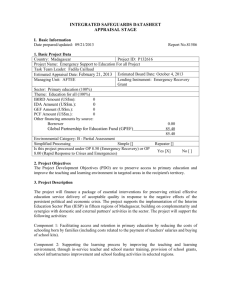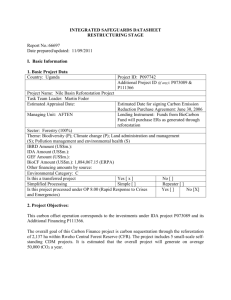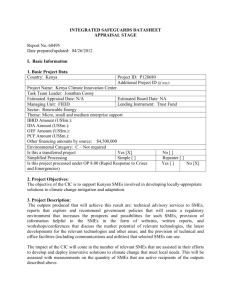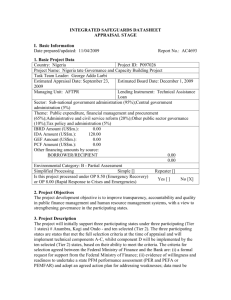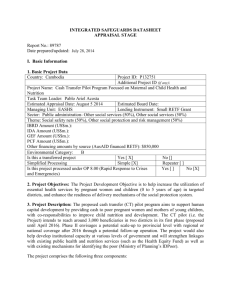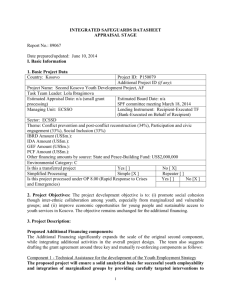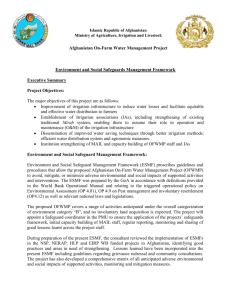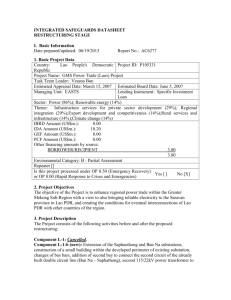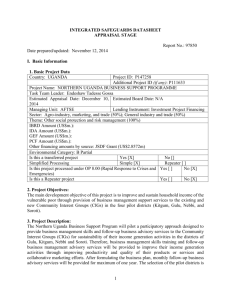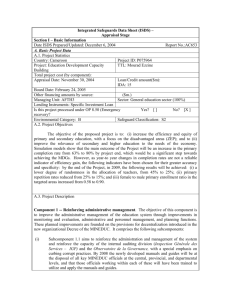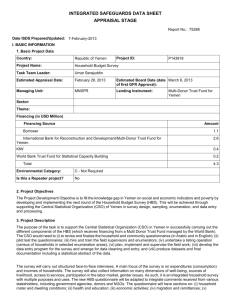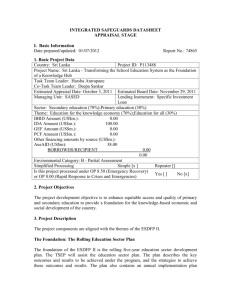integrated safeguards datasheet - Documents & Reports
advertisement
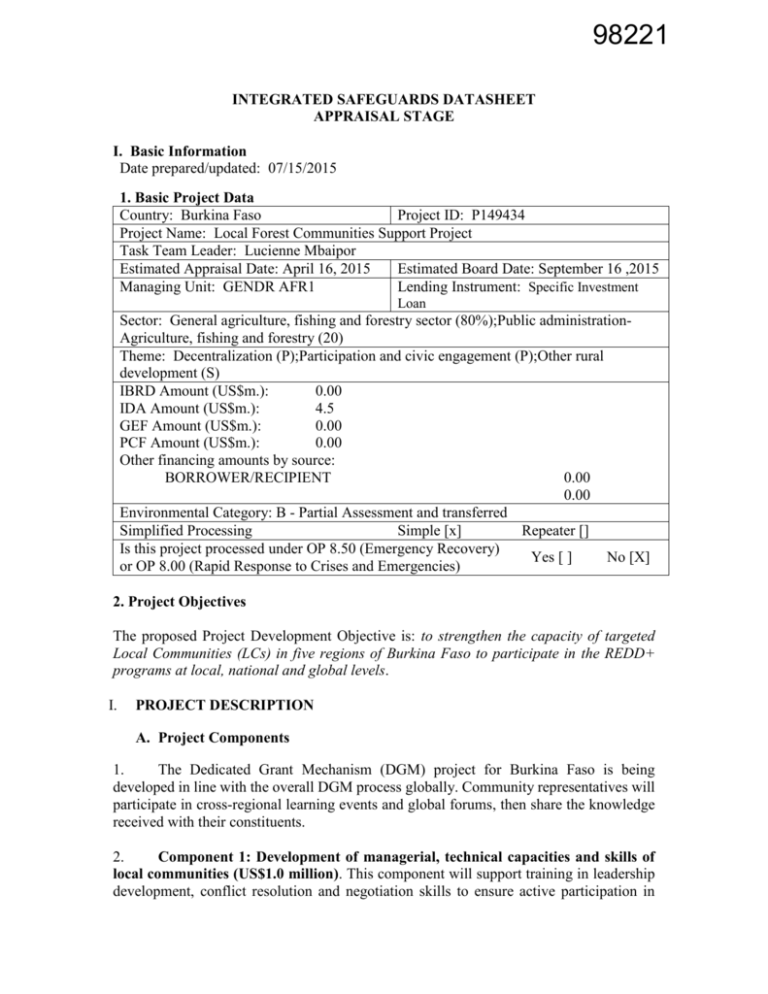
98221 INTEGRATED SAFEGUARDS DATASHEET APPRAISAL STAGE I. Basic Information Date prepared/updated: 07/15/2015 1. Basic Project Data Country: Burkina Faso Project ID: P149434 Project Name: Local Forest Communities Support Project Task Team Leader: Lucienne Mbaipor Estimated Appraisal Date: April 16, 2015 Estimated Board Date: September 16 ,2015 Managing Unit: GENDR AFR1 Lending Instrument: Specific Investment Loan Sector: General agriculture, fishing and forestry sector (80%);Public administrationAgriculture, fishing and forestry (20) Theme: Decentralization (P);Participation and civic engagement (P);Other rural development (S) IBRD Amount (US$m.): 0.00 IDA Amount (US$m.): 4.5 GEF Amount (US$m.): 0.00 PCF Amount (US$m.): 0.00 Other financing amounts by source: BORROWER/RECIPIENT 0.00 0.00 Environmental Category: B - Partial Assessment and transferred Simplified Processing Simple [x] Repeater [] Is this project processed under OP 8.50 (Emergency Recovery) Yes [ ] No [X] or OP 8.00 (Rapid Response to Crises and Emergencies) 2. Project Objectives The proposed Project Development Objective is: to strengthen the capacity of targeted Local Communities (LCs) in five regions of Burkina Faso to participate in the REDD+ programs at local, national and global levels. I. PROJECT DESCRIPTION A. Project Components 1. The Dedicated Grant Mechanism (DGM) project for Burkina Faso is being developed in line with the overall DGM process globally. Community representatives will participate in cross-regional learning events and global forums, then share the knowledge received with their constituents. 2. Component 1: Development of managerial, technical capacities and skills of local communities (US$1.0 million). This component will support training in leadership development, conflict resolution and negotiation skills to ensure active participation in initiatives related to natural resource-based mitigation and adaptation to climate change, training and capacity development for securing and strengthening customary land tenure and resource rights and traditional forest management systems of local communities, and for reducing cultural, social, economic and policy barriers to such rights and to the continuance and enhancement of traditional forest management systems. 3. Component 2: Support the development of economic and sustainable natural resource management activities (US$2.7 million). This component will (i) support the implementation of activities that contribute to improving the income of targeted local communities, and (ii) promote the implementation of measures likely to ensure sustainable management of natural resources and living conditions in the target villages. The component will be divided into two sub-components: 4. Component 3: Coordination, management, monitoring and evaluation (US$0.8 million). This component will ensure effective operational planning, monitoring and implementation of the Grant. It will finance the cost of the NEA. The NEA will be the secretariat for the NSC and will develop country-specific review and risk assessment criteria, and provide operational and financial reporting to the World Bank and NSC. 4. Project Location and salient physical characteristics relevant to the safeguard analysis The project will have interventions at the national as well as sub-national levels. National level interventions will occur predominantly in Ouagadougou while investments at the local level will occur in 5 Regions and 32 communes (26 rural and 6 urban) that border classified forest and woodland areas (East, le Nazinon, le Chapelet du Mouhoun, Far-South and Bontioli). The exact locations for specific investments are not yet known. 5. Environmental and Social Safeguards Specialists M. Joseph Ellong (GSURR) Mr. Emeran Serge M. Menang Evouna (GENDR AFR1) 6. Safeguard Policies Environmental Assessment OP/BP 4.01 Triggered? Explanation (Optional) Yes The project activity under sub component 2 will support sustainable management and development of natural forests as well as restoration and natural regeneration of previously degraded or converted forests, economic activities and rural livelihoods practices such as putting in place infrastructures and equipments for production, transformation and conservation of product. These activities may have environmental impacts even at very small and limited scale. A programmatic Environmental and Social Management Framework (ESMF) has been prepared at the global level for the DGM as a whole and has been shared and reviewed by IPLC leaders during the first NSC session (Oct. 31 – Nov. 3, 2014). An ESMF for the FIP project has been prepared, consulted upon, and disclosed in the country and at the InfoShop. The DGM project updated the ESMF prepared under FIP Project as the two projects have the same sites, consulted upon and disclosed in the country and at the InfoShop. Natural Habitats OP/BP 4.04 No Project activities will not be undertaken near or inside critical ecosystems. As the project will enhance the quality of the management of forest and woodlands, particular attention will be paid to these ecosystems. The conception of the subprojects will avoid any threat to critical ecosystem. The ESMF elaborated in accordance with OP4.01 for the FIP project is updated for the DGM project and provided guidance on avoiding or mitigating impacts on natural habitats. Forests OP/BP 4.36 Yes No activity of the project is expected to promote timber exploitation or to finance activities which will contribute to destroy the forest. OP4.36 is triggered to underscore the attention that must be paid to aspects related to the protection of the forest resources during project preparation and implementation. Improving Forestry management policies is a primary focus of this project. While the project will explore integrated forest management as part of a strategy of increasing carbon sequestration potential the main expected result is improved forest management. The ESMF of the FIP project is updated by the DGM project includes guidance on managing forestry issues. Pest Management OP 4.09 No N/A Physical Cultural Resources OP/BP 4.11 Yes This policy is triggered because the project will support under Component 2, construction of infrastructures and forages that may need earth excavations. In addition, Burkina Faso has a rich cultural heritage that needs to be preserved. The ESMF of the FIP project is updated to cover this aspect. Chance find procedures will be incorporated into civil works contracts and buffer zones will be created to avoid any damage to cultural resources such as sacred forests and graveyards. The project implementation team will be extra vigilant to ensure that project activities do not affect such sites. Indigenous Peoples OP/BP 4.10 No There are no indigenous people in the project area. Involuntary Resettlement OP/BP 4.12 Yes No involuntary resettlement is anticipated; however, because of the possibility of limitation of access (essentially related to the possible impact on traditional transhumance corridors and grazing lands) a process framework for the FIP project has also been updated according to the DGM context, approved and disclosed in the targeted areas and at the InfoShop. Safety of Dams OP/BP 4.37 No The project will not finance dam or damrelated investments. Projects on International Waterways OP/BP 7.50 No The project will not depend on international waterways and will not finance water resources use activities. Projects in Disputed Areas OP/BP 7.60 No This project is not being implemented in any disputed areas. II. Key Safeguard Policy Issues and Their Management A. Summary of Key Safeguard Issues 1. Describe any safeguard issues and impacts associated with the proposed project. Identify and describe any potential large scale, significant and/or irreversible impacts: No significant environmental impacts are expected from this project as its objective is to promote sound natural resources management and improve animal and vegetal biodiversity. However, it is necessary for the sake of the environmental integrity of the project to follow a structured assessment process to ensure that no activities will have unintended consequences on the environment. The ESMF had identified the following risks or impacts that will need special attention even if they are very limited and in small scale: vegetation destruction, deforestation, poaching and illegal logging increase; increased demand of fuel wood and construction wood in rural areas; wildlife habitat destruction; loss of biodiversity; soil erosion; pasture encroachment on crop fields; decrease of groundwater level; soil and groundwater pollution if pesticides, herbicides, and fertilizers are misused; reduction of households means of subsistence due to conservation efforts; productivity decrease for mono specific planting which can be more vulnerable to diseases, insects, fire, etc.; overexploitation of forest products NTFPs. 2. Describe any potential indirect and/or long term impacts due to anticipated future activities in the project area: Land issues are very sensitive in the current context of Burkina Faso and the Bank has reviewed extensively the implication of land-based intervention in the context of the FIP and the DGM activities. In some instances, in Component 2, funding modern livestock (breeding) or forage crop could raise tensions between farmers and herders over access of cattle to water holes or grazing fields. The project will use the existing process (charte foncière) in order to reach a consensus. In case of irreconcilable disagreement, the project will not finance the corresponding activity. 3. Describe any project alternatives (if relevant) considered to help avoid or minimize adverse impacts. 1) The project opted not to develop activities with negative impacts. For that purpose, an ineligible activities list for DGM funding is included in the PAD and will be reflected in the project implementation manual. 2) The project positively excluded sensible areas. 4. Describe measures taken by the borrower to address safeguard policy issues. Provide an assessment of borrower capacity to plan and implement the measures described. A programmatic Environmental and Social Management Framework (ESMF) has been prepared at the global level for the DGM as a whole and has been shared and reviewed by IPLC leaders during the first NSC session (Oct. 31 – Nov. 3, 2014). In addition, considering the similarity of objectives and implementation arrangements, the safeguards instruments to be used are based to a great extent on those of the FIP project that was approved in October 2013. Accordingly, an Environmental and Social Management Framework has been prepared; On the social side, because of potential limitation to accessing some lands particularly used traditionally as cattle trails or grazing fields, a Process Framework has also been prepared that describes the principles and procedures to follow in such instances. Based on Burkina Faso's past experiences with World Bank projects and safeguard measures including on decentralization, the capacity of the borrower, while limited, is adequate to carry out the proposed safeguard policy measures. Since the exact nature and location of the activities cannot be identified prior to appraisal, the project will update the ESMF and the Process Framework prepared for the FIP project in Burkina to ensure that potential negative environmental and social impacts of future subprojects are identified and appropriately mitigated. The two documents were approved and disclosed in Burkina and at the Bank’s InfoShop. 5. Identify the key stakeholders and describe the mechanisms for consultation and disclosure on safeguard policies, with an emphasis on potentially affected people. The ESMF and the Process Framework of the FIP project mentioned above have been consulted upon and disclosed on October 28, 2013. They were updated consulted and disclosed in the Country and in InfoShop. While the project will feed into a national climate change and REDD+ strategy, the key stakeholders will be community members, local and international NGOs in the project site at the national level. Consultation was done with the Communities in the project’s sites to share the documents recommendations. The environmental and social documents for the project will be available in the regional project offices and at the national level. B. Disclosure Requirements Date Environmental Assessment/Audit/Management Plan/Other: Was the document disclosed prior to appraisal? No Date of receipt by the Bank 03/30/2015 Date of "in-country" disclosure 06/02/2015 Date of submission to InfoShop 05/31/2015 For category A projects, date of distributing the Executive N.A. Summary of the EA to the Executive Directors Resettlement Action Plan/Framework/Policy Process: Was the document disclosed prior to appraisal? No Date of receipt by the Bank 05/31/2015 Date of "in-country" disclosure 06/02/2015 Date of submission to InfoShop 07/14/2015 Indigenous Peoples Plan/Planning Framework: Was the document disclosed prior to appraisal? N/A Date of receipt by the Bank Date of "in-country" disclosure Date of submission to InfoShop Pest Management Plan: Was the document disclosed prior to appraisal? N/A/ Date of receipt by the Bank Date of "in-country" disclosure Date of submission to InfoShop * If the project triggers the Pest Management and/or Physical Cultural Resources, the respective issues are to be addressed and disclosed as part of the Environmental Assessment/Audit/or EMP. If in-country disclosure of any of the above documents is not expected, please explain why: C. Compliance Monitoring Indicators at the Corporate Level (to be filled in when the ISDS is finalized by the project decision meeting) OP/BP/GP 4.01 - Environment Assessment Does the project require a stand-alone EA (including EMP) report? If yes, then did the Regional Environment Unit or Sector Manager (SM) review and approve the EA report? Are the cost and the accountabilities for the EMP incorporated in the credit/loan? OP 4.09 - Pest Management Does the EA adequately address the pest management issues? Is a separate PMP required? If yes, has the PMP been reviewed and approved by a safeguards specialist or SM? Are PMP requirements included in project design? If yes, does the project team include a Pest Management Specialist? OP/BP 4.10 - Indigenous Peoples Has a separate Indigenous Peoples Plan/Planning Framework (as appropriate) been prepared in consultation with affected Indigenous Peoples? If yes, then did the Regional unit responsible for safeguards or Sector Manager review the plan? If the whole project is designed to benefit IP, has the design been reviewed and approved by the Regional Social Development Unit or Sector Manager? OP/BP 4.12 - Involuntary Resettlement Has a resettlement plan/abbreviated plan/policy framework/process framework (as appropriate) been prepared? If yes, then did the Regional unit responsible for safeguards or Sector Manager review the plan? OP 7.50 - Projects on International Waterways Have the other riparians been notified of the project? If the project falls under one of the exceptions to the notification requirement, has this been cleared with the Legal Department, and the memo to the RVP prepared and sent? Has the RVP approved such an exception? The World Bank Policy on Disclosure of Information Have relevant safeguard policies documents been sent to the World Bank's InfoShop? No N/A N/A Yes No No No No No Yes Yes No No N/A Yes Have relevant documents been disclosed in-country in a public place in a form and language that are understandable and accessible to project-affected groups and local NGOs? All Safeguard Policies Have satisfactory calendar, budget and clear institutional responsibilities been prepared for the implementation of measures related to safeguard policies? Have costs related to safeguard policy measures been included in the project cost? Does the Monitoring and Evaluation system of the project includes the monitoring of safeguard impacts and measures related to safeguard policies? Have satisfactory implementation arrangements been agreed with the borrower and the same been adequately reflected in the project legal documents? Yes Yes Yes Yes Yes D. Approvals Signed and submitted by: Task Team Leader: Environmental Specialist: Social Development Specialist Additional Environmental and/or Social Development Specialist(s): Name Ms. Mbaipor Lucienne Mr. Emeran Serge M. Menang Evouna Mr. Joseph Ellong Approved by: Regional Safeguards Coordinator: Comments: Sector Manager: Comments: Ms Johanna Van Tilburg Mr Benoit Bosquet Date
